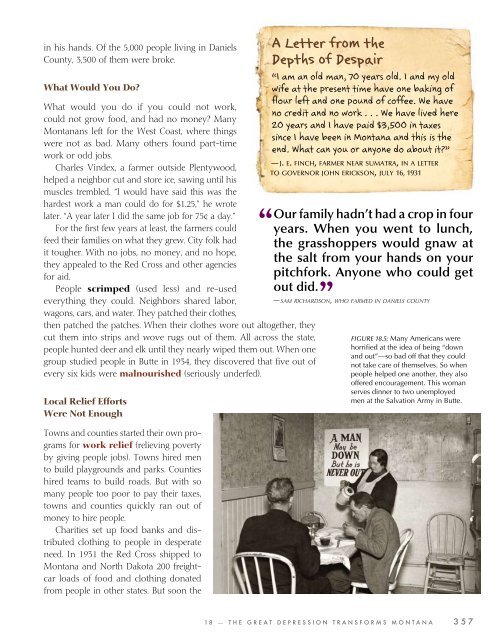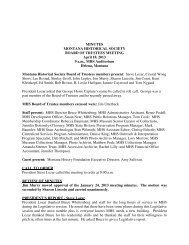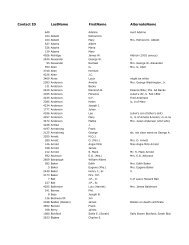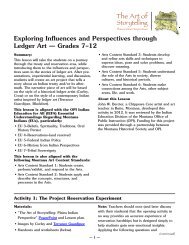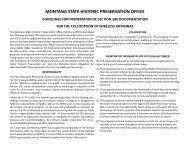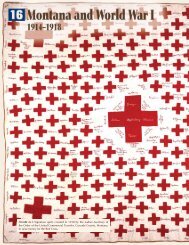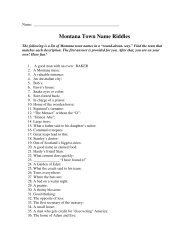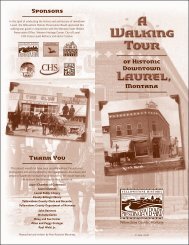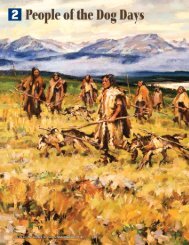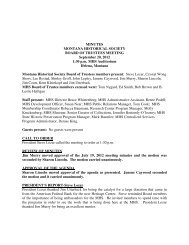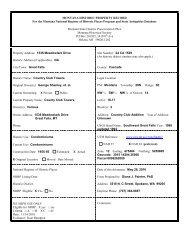No Place To Go, by Maynard Dixon, 1935 - Montana Historical Society
No Place To Go, by Maynard Dixon, 1935 - Montana Historical Society
No Place To Go, by Maynard Dixon, 1935 - Montana Historical Society
Create successful ePaper yourself
Turn your PDF publications into a flip-book with our unique Google optimized e-Paper software.
in his hands. Of the 5,000 people living in Daniels<br />
County, 3,500 of them were broke.<br />
What Would You Do?<br />
What would you do if you could not work,<br />
could not grow food, and had no money? Many<br />
<strong>Montana</strong>ns left for the West Coast, where things<br />
were not as bad. Many others found part-time<br />
work or odd jobs.<br />
Charles Vindex, a farmer outside Plentywood,<br />
helped a neighbor cut and store ice, sawing until his<br />
muscles trembled. “I would have said this was the<br />
hardest work a man could do for $1.25,” he wrote<br />
later. “A year later I did the same job for 75¢ a day.”<br />
For the fi rst few years at least, the farmers could<br />
feed their families on what they grew. City folk had<br />
it tougher. With no jobs, no money, and no hope,<br />
they appealed to the Red Cross and other agencies<br />
for aid.<br />
People scrimped (used less) and re-used<br />
everything they could. Neighbors shared labor,<br />
wagons, cars, and water. They patched their clothes,<br />
then patched the patches. When their clothes wore out altogether, they<br />
cut them into strips and wove rugs out of them. All across the state,<br />
people hunted deer and elk until they nearly wiped them out. When one<br />
group studied people in Butte in 1934, they discovered that fi ve out of<br />
every six kids were malnourished (seriously underfed).<br />
Local Relief Efforts<br />
Were <strong>No</strong>t Enough<br />
<strong>To</strong>wns and counties started their own programs<br />
for work relief (relieving poverty<br />
<strong>by</strong> giving people jobs). <strong>To</strong>wns hired men<br />
to build playgrounds and parks. Counties<br />
hired teams to build roads. But with so<br />
many people too poor to pay their taxes,<br />
towns and counties quickly ran out of<br />
money to hire people.<br />
Charities set up food banks and distributed<br />
clothing to people in desperate<br />
need. In 1931 the Red Cross shipped to<br />
<strong>Montana</strong> and <strong>No</strong>rth Dakota 200 freightcar<br />
loads of food and clothing donated<br />
from people in other states. But soon the<br />
“<br />
A Letter from the<br />
Depths of Despair<br />
“I am an old man, 70 years old. I and my old<br />
wife at the present time have one baking of<br />
flour left and one pound of coffee. We have<br />
no credit and no work . . . We have lived here<br />
20 years and I have paid $3,500 in taxes<br />
since I have been in <strong>Montana</strong> and this is the<br />
end. What can you or anyone do about it?”<br />
—J. E. FINCH, FARMER NEAR SUMATRA, IN A LETTER<br />
TO GOVERNOR JOHN ERICKSON, JULY 16, 1931<br />
Our family hadn’t had a crop in four<br />
years. When you went to lunch,<br />
the grasshoppers would gnaw at<br />
the salt from your hands on your<br />
pitchfork. Anyone who could get<br />
out did.<br />
”<br />
—SAM RICHARDSON, WHO FARMED IN DANIELS COUNTY<br />
FIGURE 18.5: Many Americans were<br />
horrifi ed at the idea of being “down<br />
and out”—so bad off that they could<br />
not take care of themselves. So when<br />
people helped one another, they also<br />
offered encouragement. This woman<br />
serves dinner to two unemployed<br />
men at the Salvation Army in Butte.<br />
1 8 — T H E G R E A T D E P R E S S I O N T R A N S F O R M S M O N T A N A 3 5 7


